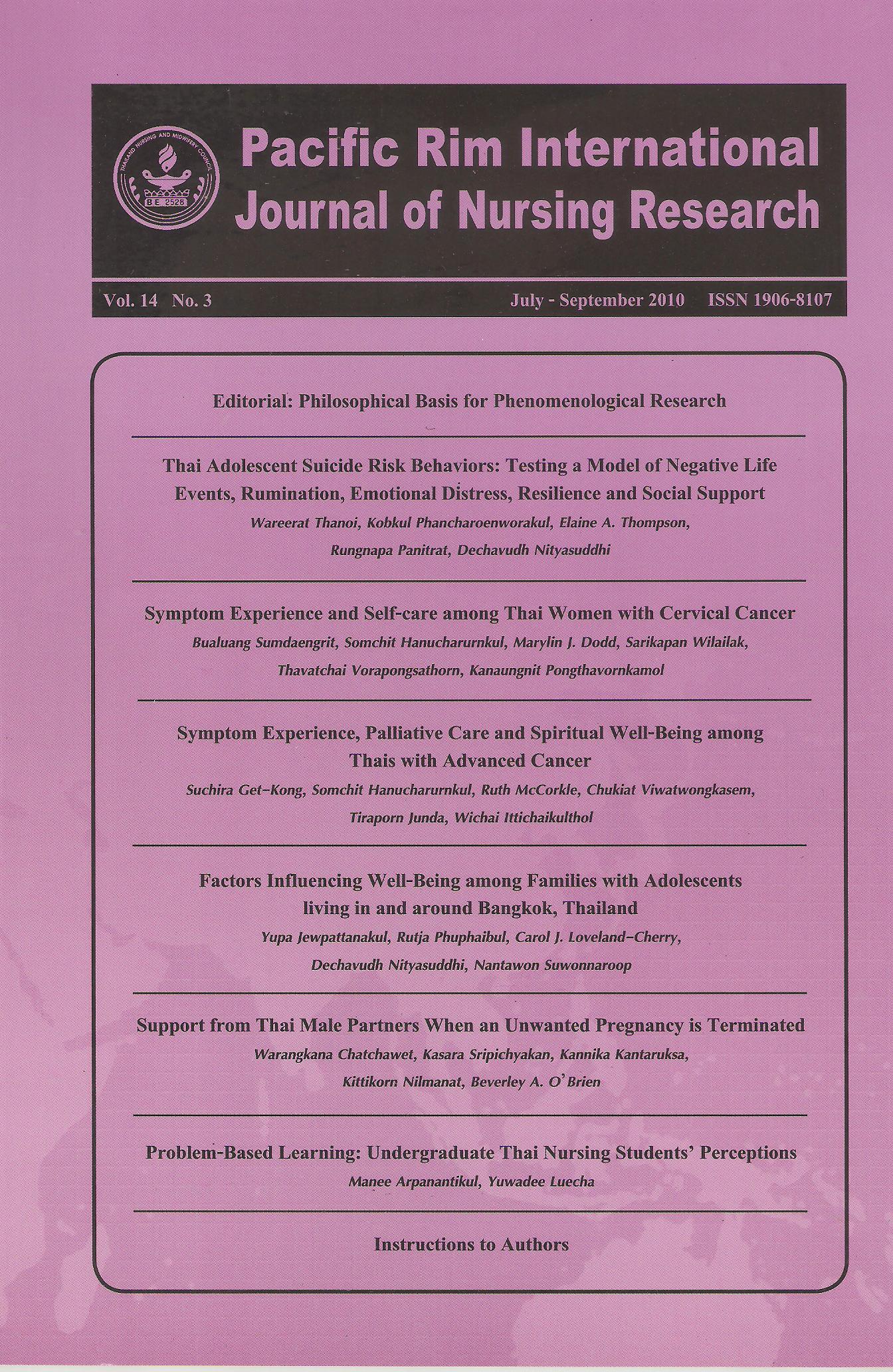Symptom Experience, Palliative Care and Spiritual Well-Being among Thais with Advanced Cancer
Keywords:
ผู้ป่วยมะเร็งระยะลุกลาม, การดูแลแบบประคับประคอง, ความผาสุกทางจิตวิญญาณ, ประสบการณ์การเผชิญอาการ, Thais with advanced cancer, Palliative care, Spiritual well-being, SymptomexperienceAbstract
บทคัดย่อ
การศึกษาภาคตัดขวางเชิงบรรยายในผู้ป่วยมะเร็งระยะลุกลามครั้งนี้มีวัตถุประสงค์เพื่อ 1) อธิบายประสบการณ์การเผชิญอาการ การดูแลแบบประคับประคอง และความผาสุกทางจิตวิญญาณ 2) ศึกษาความสัมพันธ์ของแปรดังกล่าวทั้งสามตัว และ 3) ทำนายผาสุกทางจิตวิญญาณของผู้ป่วยมะเร็งระยะลุกลามด้วยประสบการณ์การเผชิญอาการ การดูแลแบบประคับประคอง กลุ่มตัวอย่างเป็นผู้ป่วยมะเร็งระยะลุกลามจำนวน 240 คนที่มีคุณสมบัติตามเกณฑ์ที่กำหนด เครื่องมือที่ใช้ได้แก่ แบบบันทึกข้อมูลส่วนบุคคล แบบประเมินอาการ แบบประเมินการดูแลแบบประคับประคอง และแบบวัดความผาสุกทางจิตวิญญาณ
ผลการศึกษาพบว่าอาการที่มีความชุกและความทุกข์ทรมาณสูงสุดคืออาการปวด ส่วนอาการที่เป็นบ่อยครั้งคืออาการกลืนลำบากขณะที่ อาการที่ระดับความรุนแรงสูงสุดคือ มองดูตัวเองไม่เหมือนเดิม การดูแลแบบประคับประคองที่ผู้ป่วยได้รับมีหลากหลายวิธีการทั้งแบบใช้ยา และ ไม่ใช้ยา ยาที่ใช้มากที่สุดคือยาบรรเทาอาการปวดและยาเสริมฤทธิ์สำหรับการดูแลจัดการแบบไม่ใช้ยา วิธีการที่ผู้ป่วยเลือกใช้ 5 วิธีแรกคือ การได้รับข้อมูล/ คำแนะนำในการดูแลตนเองการได้รับการพูดคุยให้กำลังใจ การปรับเปลี่ยนอาหารและพฤติกรรมการรับประทานอาหาร ใช้การอ่านหนังสือธรรมะ/คัมภีร์ตามศาสนาที่นับถือและการปฏิบัติศาสนกิจ การรับประทานวิตามินและผลิตภัณฑ์เสริมอาหาร โดยวิธีที่ผู้ป่วยประเมินว่ามีประสิทธิภาพมากที่สุดคือการได้รับข้อมูล/ คำแนะนำในการดูแลตนเอง การได้รับการพูดคุยให้กำลังใจ ซึ่งพบว่าพยาบาลเป็นแหล่งประโยชน์สำคัญในการให้ความช่วยเหลือ ผู้ป่วยกลุ่มนี้มีความผาสุกทางจิตวิญญาณในระดับปานกลางถึงสูง สำหรับความสัมพันธ์ขององค์ประกอบของอาการทั้งสามด้านคือ ความถี่ ความรุนแรงและความทุกข์ทรมานมีความสัมพันธ์ทางบวกซึ่งกันและกัน การดูแลแบบประคับประคองมีความสัมพันธ์ทางบวกกับความผาสุกทางจิตวิญญาณแต่มีความสัมพันธ์ทางลบกับประสบการณ์อาการทั้งสามด้าน ส่วนความผาสุกทางจิตวิญญาณมีความสัมพันธ์ทางลบกับประสบการณ์อาการทั้งสามด้าน ในการทำนายความผาสุกทางจิตวิญญาณด้วยการดูแลแบบประคับประคองและในประสบการณ์แต่ละด้านพบว่า ระดับความรุนแรงของอาการและการดูแลแบบประคับประคองสามารถอธิบายความแปรปรวนของความผาสุกทางจิตวิญญาณได้ถึงร้อยละ 48.9 ระดับความทุกข์ทรมาณของอาการและการดูแลแบบประคับประคองสามารถอธิบายได้ร้อยละ 48.8 และระดับความถี่ของอาการและการดูแลแบบประคับประคองสามารถอธิบายได้ร้อยละ 48.3
คำสำคัญ: ผู้ป่วยมะเร็งระยะลุกลาม; การดูแลแบบประคับประคอง; ความผาสุกทางจิตวิญญาณ; ประสบการณ์การเผชิญอาการ
Abstract
This descriptive cross-sectional study of Thais with advanced cancer aimed to: 1)describe symptom experiences, palliative care strategies and spiritual well-being; 2) examinethe relationships among these three variables; and, 3) determine predictability of spiritual wellbeingby symptoms experienced and palliative care received. Two hundred and forty Thaiswith advanced cancer were purposively selected to respond to four questionnaires: PersonalInformation Questionnaire; Memorial Symptom Assessment Scale; Palliative Care AssessmentForm; and, Spiritual Well-Being Scale.
The most common symptom reported by prevalence and distress was pain. Difficultyswallowing was reported as the most frequent symptom, while “I don’t look like myself” wasthe most severe symptom. The palliative care methods used were a combination of pharmacologicaland non-pharmacological management strategies. Analgesics, specifically morphine, were the mostcommon pharmacological agents used. The five non-pharmacological strategies most frequentlyused were: getting information/advice on self care; talking to someone who gave support/encouragement; changing food/eating behavior; reading Dhamma’s book/bible of own religionand making merit; and, taking vitamins or dietary supplements. The two most effective non-pharmacologicalmanagement strategies included: getting information/advice regarding self-care and talking to someonewho gave support and encouragement. Nurses were the most often listed care providers involved inadministering non-pharmacological strategies, especially regarding psychosocial care. Subjectsreported moderate to high spiritual well-being. Positive relationships were found among the threedimensions of the symptom experience (frequency, severity & distress). Palliative care was found tohave a positive relationship with spiritual well-being and a negative relationship with the three symptomdimensions, while spiritual well-being had a negative relationship with the three symptom dimensions.Symptom severity and palliative care, together, accounted for 48.9% of variance in spiritual well-being,while symptom distress and palliative care accounted for 48.8%, and symptom frequency andpalliative care explained 48.3%.
Key Words: Thais with advanced cancer; Palliative care; Spiritual well-being; Symptomexperience
Downloads
How to Cite
Issue
Section
License
Copyright: The Pacific Rim International Journal of Nursing Research, Thailand Nursing & Midwifery Council has exclusive rights to publish, reproduce and distribute the manuscript and all contents therein.








.png)



